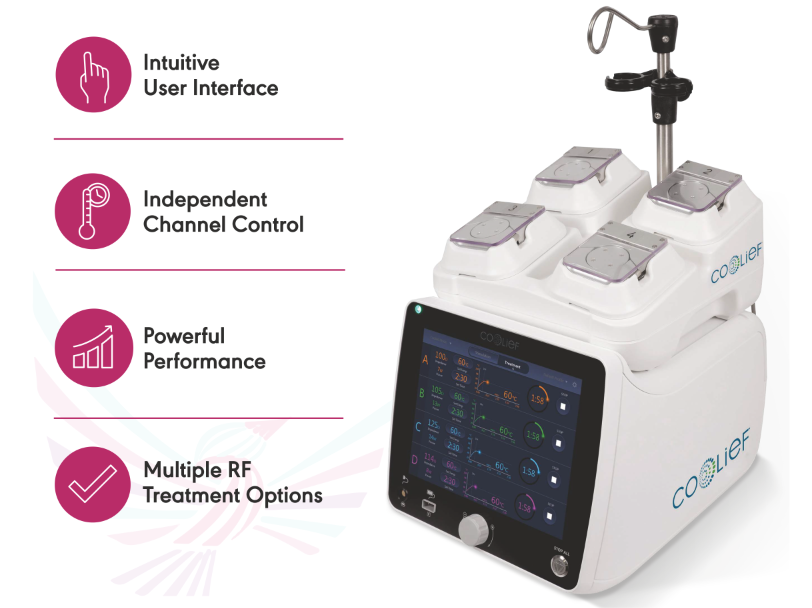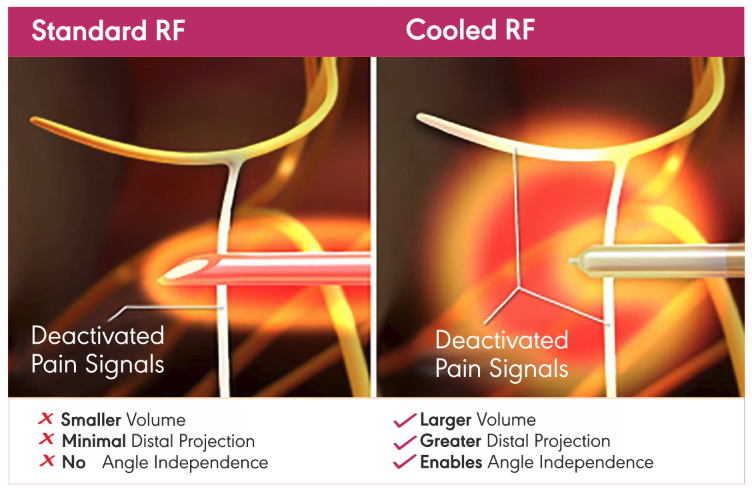C
The field of pain management has seen remarkable advancements in recent years, offering patients new and improved treatment options. One such breakthrough is the comparison between traditional Radiofrequency (RF) treatment and Cooled Radiofrequency (CRF) treatment. This comparison can be likened to the difference between standard definition TV and HD – there simply is no comparison. In this article, we will explore the benefits of Cooled Radiofrequency and how it outshines traditional RF treatment.
Introduction
Living with chronic pain can be debilitating, affecting one’s quality of life and overall well-being. Thankfully, advancements in pain management have paved the way for more effective and innovative treatments. In this article, we will delve into the benefits of Cooled Radiofrequency (CRF) treatment and how it surpasses traditional RF treatment, providing extended pain relief, a minimally invasive approach, and an alternative to surgical procedures.

Understanding traditional RF treatment
Traditional Radiofrequency (RF) treatment has long been used to target nerves responsible for transmitting pain signals. It involves the use of heat to deactivate these nerves, thereby providing temporary pain relief. However, the limitations of traditional RF treatment have become evident as newer techniques have emerged.
The emergence of Cooled Radiofrequency
Cooled Radiofrequency (CRF) treatment is a modernized version of traditional RF treatment that has revolutionized the field of pain management. CRF treatment enables the targeting of larger areas of tissue, resulting in the deactivation of more sensory nerves and, consequently, less pain. Unlike standard RF treatment, where the heat is concentrated on the probe, CRF treatment distributes the heat further, reducing the need for extensive probing.
The benefits of Cooled Radiofrequency:
Extended pain relief
One of the standout advantages of Cooled Radiofrequency treatment is its ability to provide extended pain relief. While traditional RF treatment may offer relief for a few months, CRF treatment can alleviate pain for more than 24 months. This prolonged period of relief allows patients to regain control of their lives and enjoy freedom from chronic pain.
Minimally invasive procedure
Cooled Radiofrequency treatment is a minimally invasive procedure that offers a less intrusive alternative to surgical interventions. Unlike hip or knee replacement surgery, which often requires lengthy recovery periods and significant lifestyle changes, CRF treatment provides relief without the need for invasive procedures.
Avoidance of hip or knee replacement surgery
For individuals suffering from hip or knee pain, the prospect of surgery can be daunting. Cooled Radiofrequency treatment offers a non-surgical option, enabling patients to avoid the potential risks and challenges associated with joint replacement surgery. CRF treatment targets the affected nerves, providing pain relief and improved physical movement without the need for invasive measures.

The shortcomings of medication and surgery
While medication is a common method for pain management, it often falls short in effectively targeting the root cause of the pain. Additionally, long-term medication use can come with various side effects and may not provide sustainable relief. On the other hand, surgery carries inherent risks and requires significant recovery time, which can impact an individual’s lifestyle and mobility.
The superiority of Cooled Radiofrequency
The real difference lies in the comparison between traditional RF treatment and Cooled Radiofrequency treatment. With CRF treatment, larger areas of tissue can be targeted, allowing for the deactivation of more sensory nerves. This comprehensive approach ensures that variable nerve paths, often missed by standard RF treatment, are effectively addressed. Furthermore, the cooling properties of CRF treatment prevent tissue damage, ensuring a safe and efficient procedure.
The advantages of Cooled Radiofrequency
Cooled Radiofrequency treatment brings numerous benefits. The extended duration of pain relief, for more than 24 months, enables individuals to experience long-lasting freedom from chronic pain. Moreover, improved physical movement contributes to an enhanced quality of life, allowing patients to engage in activities they previously found challenging. With CRF treatment, there is also a reduced reliance on pain relief drugs, offering a more holistic and sustainable approach to pain management.
Reclaiming a pain-free life with Cooled Radiofrequency
Cooled Radiofrequency treatment represents a breakthrough in pain management, offering individuals the opportunity to reclaim their lives without the constraints of chronic pain. By choosing CRF treatment, patients can experience prolonged relief, improved mobility, and a reduced need for pain medication. Say goodbye to traditional limitations and embrace the possibilities that Cooled Radiofrequency brings.
Conclusion
Cooled Radiofrequency treatment has ushered in a new era of pain management, surpassing the limitations of traditional RF treatment. With its ability to target larger tissue areas, deactivate more sensory nerves, and provide extended pain relief, CRF treatment offers patients a superior alternative. By opting for Cooled Radiofrequency, individuals can break through the barriers of chronic pain and embrace a life free from traditional limitations.
FAQs
1. How long does the pain relief from Cooled Radiofrequency treatment last?
Cooled Radiofrequency treatment can provide pain relief for more than 24 months, allowing for an extended period of freedom from chronic pain.
2. Is Cooled Radiofrequency treatment a minimally invasive procedure?
Yes, Cooled Radiofrequency treatment is a minimally invasive procedure that offers a less intrusive option compared to surgical interventions.
3. Can Cooled Radiofrequency treatment replace hip or knee replacement surgery?
Cooled Radiofrequency treatment can be an alternative to hip or knee replacement surgery, providing pain relief without the need for invasive procedures.
4. How does Cooled Radiofrequency treatment differ from traditional RF treatment?
Cooled Radiofrequency treatment targets larger tissue areas and deactivates more sensory nerves, surpassing the limitations of traditional RF treatment.
5. What are the advantages of Cooled Radiofrequency treatment for doctors?
Cooled Radiofrequency treatment allows doctors to target larger areas, address complex nerve paths, and enhance precision during the procedure.

